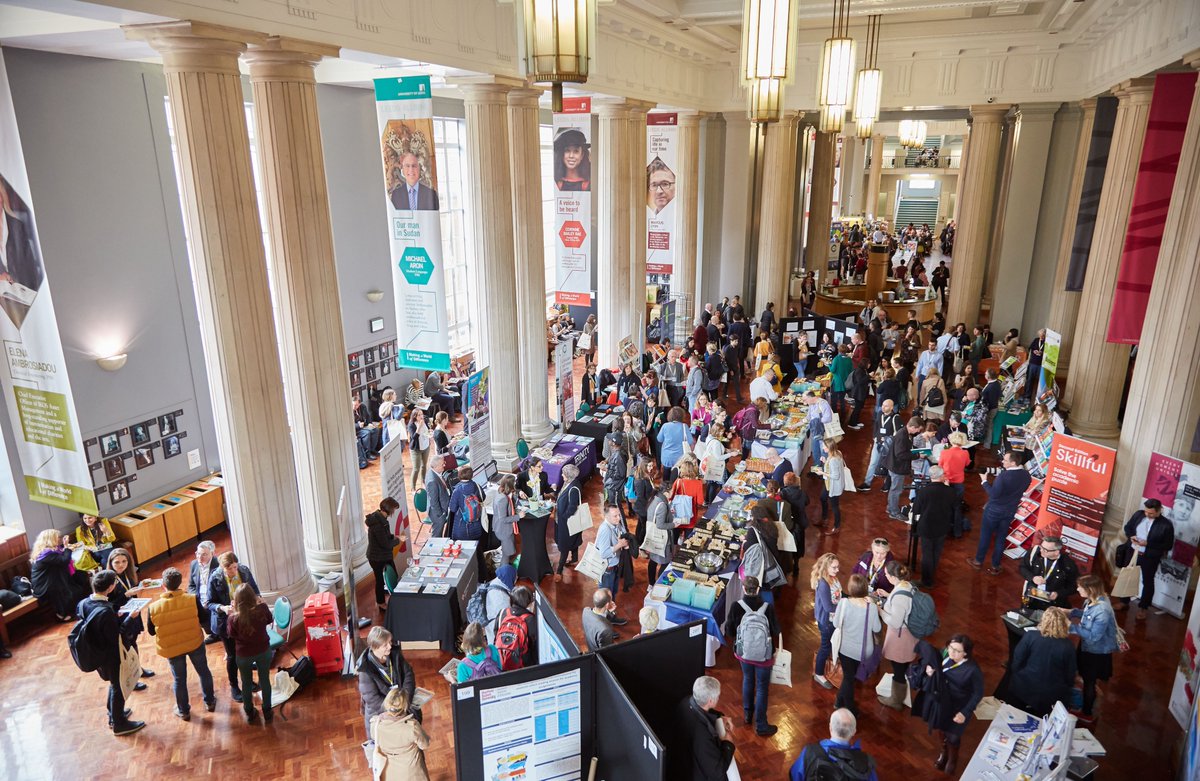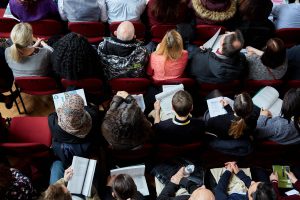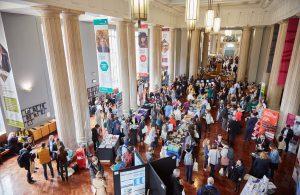
May 30, 2019, by Julia Molinari
Reflections of a Conference Attendee
BALEAP 2019 Conference, Leeds, UK
Following the recent BALEAP conference in Leeds – a key appointment in the EAP calendar – CELE’s pressessional Course Leader, John Hall, reflects on themes for CELE to consider. Specifically, John considers the need to ‘humanise’ the curriculum. He reports on the importance of critical engagement to enhance student agency; the need for teachers to take on the student perspective; the limits of standardised assessment; and the extent to which students should use their first languages in class.
I hadn’t been to a conference in years. Little by little the pockets of quality time needed to turn fleeting thoughts into coherent ideas had shrunk.
So it was good to find myself energised on returning to work after the recent Leeds BALEAP conference, remembering the parts that conference attendance can reach and that on reflection had, in the past, always helped to influence opinions, initiate discussions, solidify plans and underpin directions.

‘Leeds, UK’ – Copyright https://baleap2019.co.uk/
I went to Leeds with the conscious intention of feeding back to colleagues on my return. But in what form? It became clear from my notes at the end of the first day that my attention was drawn to concerns that connected in some way to embryonic ideas that I was not fully aware I had. Looking back now, my mind recalls the conference as a whole rather than a series of different sessions, the link being my own train of thought across the three days.
With this in mind I can hardly claim that the conclusions arrived at below are exactly what the presenters themselves foregrounded or even intended. They are my own take and relate to where I feel we are with the courses I lead and where we could perhaps go next. Here is just a small selection.
Peter Matthews from Leeds University looked at the challenges facing international students in the transition to UK HE with regard to written academic discourse. Through a research project that allowed students to evaluate their own work and predict tutors’ feedback, he concluded that through critical engagement, students could gain a better understanding of the process of creating academic texts and thus establish their own strategies for improvement.

‘BALEAP attendees’ Copyright 2019 https://twitter.com/alexanderding/status/1125813327546994693
It made me wonder in what other ways we could help strengthen student ‘agency’ as a tool for adaptation, what we could learn from what students themselves bring to the table as well as just setting rules for them to follow.
Anna Murawska from INTO Newcastle University had been an international student herself and recalled how powerless she had felt initially when confronted with dense academic texts. They appeared to her as dauntingly complex linguistic objects to be solved like maths puzzles, her own role being a junior decoder rather than a grown up equal. She gradually became empowered as she learned to engage more confidently with written texts in English. She asked whether greater scope could be given in EAP for more visceral responses, and whether we could find a place in our classes for L1 sources as a way into critical reading. It seemed to me a reasonable thought that confidence to engage with the ideas of published authors could be boosted by temporarily removing the language barrier. Anna went on to consider the idea of assessment that is more reactive rather than based around standard comprehension.

‘Reflection’ WikiCommons
My concluding thoughts centred on how we could consider things more from the students’ perspective and think laterally about previously off-limits areas like the use of L1 texts.
Louise Palamour from Southampton University examined the use of traditional ‘objective’ marking criteria, and asked us to consider how accurate a picture of a student’s ability we get from this. Was it even fair and ethical? In practice we all have a social filter that influences our reactions to students’ nervousness, health, IT problems, or effort, and inevitably we make comparisons with previous performance or that of other students. These are often used as reasons to justify our mark. If we value ’the human dimension’ (of her title), perhaps we shouldn’t be so worried about their influence when applying the marking criteria. Isn’t there a danger of assessing a student’s ability in 10-15 mins without taking into account performance over the rest of the course?

‘Reflection’ WikiCommons
I liked the point she made about recognising ‘the unhelpful traces of large-scale standardised assessment in educational assessment’, and it made me question whether we need to be a bit more open to re-examining certain handed down truths and questioning their validity when they are transplanted in different contexts.
Amanda Brown from Syracuse University in the USA compared ‘immersive’ and ‘non immersive’ approaches to EAP, using a study in which students were able to choose whether to use L1 and L2 in the classroom. She tentatively concluded that the non-immersive approach might bring better levels of achievement for lower language level groups, but that it was less clear cut for higher levels.

‘Reflection’ WikiCommons
It again made me reflect on our (my?) unquestioning acceptance of established rules and practices, such as bans on L1 in the classroom. Are those of us ‘in charge’ subconsciously uncomfortable with any role re-balance between tutors and students? Should we not be more concerned with promoting student agency, where effective, and be prepared to consider counter-intuitive approaches that re-position the student more at the centre of the learning process?
Speaking with colleagues after, we mulled over how institutions and their curricula seem to pass through different stages of maturity. At CELE we have perhaps reached a more grown up stage in our development, a position where we can be confident enough to take stock and make sure innovation is not a one-off event. When developing the new Presessional courses in 2012 we had plenty of progressive plans and intentions, and I think many of them have been realised. But at the time it was all very new and sudden, and it was hardly surprising therefore that those of us tasked with leading and delivering the changes were not all on the same page. As a result we were inevitably bound up with finding common ground through the establishment of new frameworks and rules, but perhaps we are in a better position now to consider the more nuanced needs of our students.

‘BALEAP chatter’ Copyright 2019 https://twitter.com/alexanderding/status/1125813327546994693
Some of the ideas from Leeds have indicated that we can be more open and flexible to new approaches, meeting students halfway or at least at a different point on the continuum, perhaps seeing them more partners rather than supplicants. Not always, not at every moment, but with an awareness that roles and relationships can be fluid. As Louise Palamour’s talk suggested – let’s give more thought to the ‘human dimension’.
What are your thoughts on the above? Did you attend these presentations? If so, what were your reactions? We’d love to hear from you?

Thank you, John, for a beautifully written piece. I didn’t get the chance to attend this conference, but I can relate to many of your thoughts and reflections, and I do share your feelings about most of these.
I (like many, I guess) have been thinking recently about my role and ‘purpose’ in my workplace, and my relationship with my students. I do feel sometimes that I (we?) stop ‘living’ my job, and focus, perhaps a bit too much, on fulfilling a list of daily tasks. And that’s when a little bell in my head (or more truthfully, my heart) signals a ‘red alert’ reminding me of my own student days, and of how valuable every single ‘human’ connection was.
I believe that student transition (and indeed any transition) is a deeply personal and existential condition that takes place within a non-personal social environment. It is the tension between what the students are experiencing and the environment within which they are transitioning that we, teachers, need to be constantly mindful of when we dream up, plan, and action our courses and ‘teaching’. To enable our students’ agency to flourish, we need to give them space to breathe, explore and influence their surroundings. I feel that the current ‘shape’ of our courses, the way(s) we view our roles, and the focus on assessment and achievement, might not allow for this to happen. Therefore, perhaps we need to learn to take more ‘risks’ and bring our own agency to the fore. Perhaps we need to create a space for ourselves first, to breathe, explore and influence our own surroundings.